This article was co-authored by Chris M. Matsko, MD. Dr. Chris M. Matsko is a retired physician based in Pittsburgh, Pennsylvania. With over 25 years of medical research experience, Dr. Matsko was awarded the Pittsburgh Cornell University Leadership Award for Excellence. He holds a BS in Nutritional Science from Cornell University and an MD from the Temple University School of Medicine in 2007. Dr. Matsko earned a Research Writing Certification from the American Medical Writers Association (AMWA) in 2016 and a Medical Writing & Editing Certification from the University of Chicago in 2017.
There are 7 references cited in this article, which can be found at the bottom of the page.
This article has been viewed 419,314 times.
If you have a medical disease that affects your breathing, such as pneumonia, asthma, chronic obstructive pulmonary disorder, or respiratory infection, you might need to use a nebulizer.[1] A nebulizer is an electric machine powered by an outlet and plug or batteries. It turns liquid medication into a fine mist that is inhaled into the patient’s lungs by a mouthpiece of a facemask. This delivers the medicated mist and helps the patient breathe better.
Steps
Preparing to Use a Nebulizer
-
1Wash your hands. Start by washing your hands for no less than 20 seconds with soap under running water. Rinse your hands and dry them off with a paper towel. Turn off the faucet using a paper towel.[2]
-
2Place the medication into the nebulizer. Unscrew the top of the nebulizer cup and put the prescribed medication into the nebulizer. Many types of respiratory medications for nebulizer treatments come in pre-measured doses. If yours is not pre-measured, measure out the exact amount prescribed for one dose. Secure the top tightly to prevent the medication from spilling out. Don't forget to plug the air compressor into an electrical outlet if it is not battery operated.
- Medications that can be put in the nebulizer include inhaled beta-agonist and anticholinergics, inhaled glucocorticoids, and inhaled antibiotics. Other inhaled medications are available for the treatment of non-respiratory diseases. Not all drugs can be aerosolized.
- The jet, or pneumatic, nebulizer is the most common type. Newer nebulizers are designed to deliver the entire mediation during inhalation. Nebulizer performance can be affected by the nebulizer method, mechanism of aerosol formation, and drug formation. If you need instructions about how to use your nebulizer, talk to your doctor or respiratory therapist.
Advertisement -
3Attach the mouthpiece. Secure it to the nebulizer cup. Although different manufactures may have slightly different jet nebulizers, most mouthpieces will attach to the top of the nebulizer cup. Most nebulizers have mouth pieces instead of face masks, since masks can lead to facial deposits.
-
4Connect the tubing. Attach one end of the oxygen tubing to the nebulizer cup. On most types of nebulizers, the tubing will connect on the bottom of the cup. Connect the other end of the tubing to an air compressor used for nebulizers.[3]
Using the Nebulizer
-
1Turn on the air compressor and use the nebulizer. Put the mouthpiece into your mouth, above the tongue, and keep your lips sealed tightly around it. Inhale slowly and deeply in through your mouth so that all the medicine goes into your lungs. Exhale either through your mouth or nose. For adults, holding the nose closed can help ensure the medicine is inhaled through the mouth.
- Consider using an aerosol mask as an alternative to a mouthpiece for young children or people that are too ill to hold the mouthpiece. Aerosol masks attach to the top of the nebulizer cup. The mask comes in pediatric and adult sizes.
-
2Continue to inhale the medication. Sit up and keep inhaling the medication until the mist stops. This usually takes about 10-15 minutes. Once all liquid is gone, the mist stops coming out. The nebulizer cup should be empty. Distract yourself by watching TV or listening to music.
- Set up an activity to occupy young children during the nebulizer treatment. Puzzles, books or coloring may help the child sit still for the length of the treatment. Ideally, hold the child in your lap since the child should be sitting straight up to receive the optimal dosage of medication.[4]
-
3Turn off the nebulizer and clean up. Be sure to unplug it from the outlet and detach the medicine cup and mouthpiece from the tubing. Wash the medicine cup and mouthpiece with warm soapy water and rinse them with water. Place the equipment on a clean towel to fully air dry. Make sure to do this after each treatment and daily.
- Don't wash the tubing. If it gets wet, replace the tubing. Also, don't put any parts of the nebulizer into a dishwasher to clean it because the heat can warp the plastic.
-
4Disinfect the nebulizer once a week. To disinfect, always follow the manufacturer's guidelines. Soak all parts, except for the tubing, in one part white distilled vinegar to three parts hot water for one hour. Discard the solution. Rinse the parts, except for the tubing, in cold water and air dry them on a clean towel. After the parts are dry, store them in a clean area in the case.[5]
- For cleanliness, if more than one person is needs a nebulizer, do not share equipment even if it is washed. Each person should use his or her own nebulizer.
Expert Q&A
Did you know you can get expert answers for this article?
Unlock expert answers by supporting wikiHow
-
QuestionWhen using a nebulizer, should I exhale through my nose or my mouth?
 Chris M. Matsko, MDDr. Chris M. Matsko is a retired physician based in Pittsburgh, Pennsylvania. With over 25 years of medical research experience, Dr. Matsko was awarded the Pittsburgh Cornell University Leadership Award for Excellence. He holds a BS in Nutritional Science from Cornell University and an MD from the Temple University School of Medicine in 2007. Dr. Matsko earned a Research Writing Certification from the American Medical Writers Association (AMWA) in 2016 and a Medical Writing & Editing Certification from the University of Chicago in 2017.
Chris M. Matsko, MDDr. Chris M. Matsko is a retired physician based in Pittsburgh, Pennsylvania. With over 25 years of medical research experience, Dr. Matsko was awarded the Pittsburgh Cornell University Leadership Award for Excellence. He holds a BS in Nutritional Science from Cornell University and an MD from the Temple University School of Medicine in 2007. Dr. Matsko earned a Research Writing Certification from the American Medical Writers Association (AMWA) in 2016 and a Medical Writing & Editing Certification from the University of Chicago in 2017.
Family Medicine Physician
-
QuestionShould I leave my nasal cannula in my nose when I use the nebulizer?
 Chris M. Matsko, MDDr. Chris M. Matsko is a retired physician based in Pittsburgh, Pennsylvania. With over 25 years of medical research experience, Dr. Matsko was awarded the Pittsburgh Cornell University Leadership Award for Excellence. He holds a BS in Nutritional Science from Cornell University and an MD from the Temple University School of Medicine in 2007. Dr. Matsko earned a Research Writing Certification from the American Medical Writers Association (AMWA) in 2016 and a Medical Writing & Editing Certification from the University of Chicago in 2017.
Chris M. Matsko, MDDr. Chris M. Matsko is a retired physician based in Pittsburgh, Pennsylvania. With over 25 years of medical research experience, Dr. Matsko was awarded the Pittsburgh Cornell University Leadership Award for Excellence. He holds a BS in Nutritional Science from Cornell University and an MD from the Temple University School of Medicine in 2007. Dr. Matsko earned a Research Writing Certification from the American Medical Writers Association (AMWA) in 2016 and a Medical Writing & Editing Certification from the University of Chicago in 2017.
Family Medicine Physician
Warnings
- If a significant adverse reaction develops, such as increased wheezing or trouble breathing, while inhaling the medication, or swelling to the mouth, stop using the nebulizer and consult your doctor. Also, if your symptoms get worse, consult your doctor. Your doctor will prepare you in advance for normal side effects, such as increased heart rate or dizziness, which patients may experience while they use a nebulizer with certain medications.[6]⧼thumbs_response⧽
Things You'll Need
- Nebulizer
- Air compressor for a nebulizer
- Prescribed medication
References
- ↑ http://kidshealth.org/parent/medical/asthma/nebulizer_inhaler.html
- ↑ http://www.cdc.gov/handwashing/
- ↑ http://www.nlm.nih.gov/medlineplus/ency/patientinstructions/000006.htm
- ↑ http://www.nationwidechildrens.org/how-to-use-a-nebulizer
- ↑ http://justnebulizers.com/caring-for-your-nebulizer/
- ↑ http://www.rxlist.com/intal-nebulizer-solution-side-effects-drug-center.htm
- http://www.nlm.nih.gov/medlineplus/ency/patientinstructions/000006.htm
About This Article
To use a nebulizer, unscrew the top of the cup and pour in a single dose of the liquid medication. Secure the mouthpiece to the cup, then attach one end of the tubing to the cup and the other end to the air compressor. Turn the air compressor on, put the mouthpiece in your mouth, and seal your lips tightly around it. Inhale slowly and deeply through your mouth and exhale through your mouth or nose. Continue this for 10-15 minutes until the liquid is gone and the mist stops. For tips on cleaning your nebulizer after using it, read on!
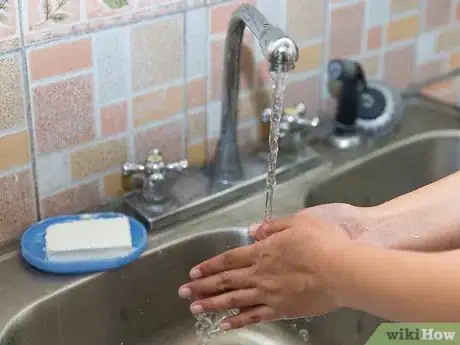




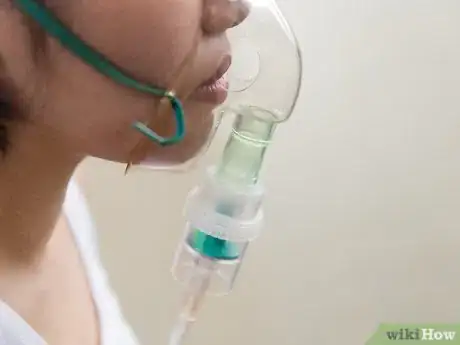
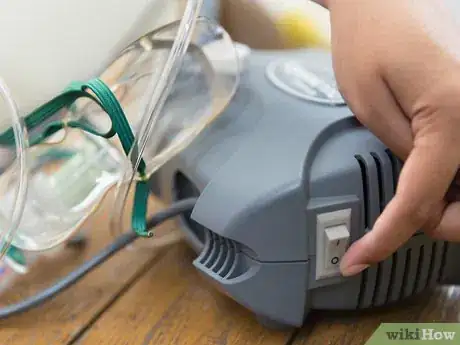
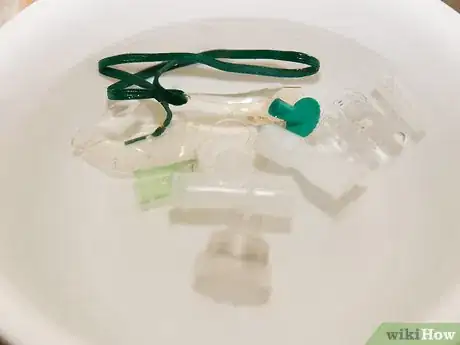
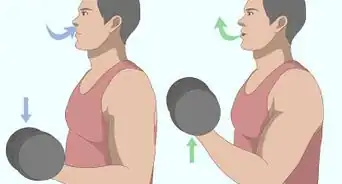
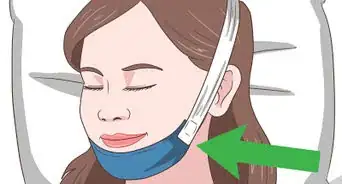
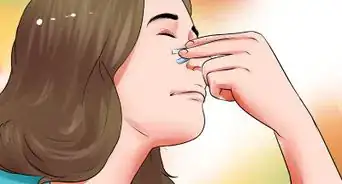



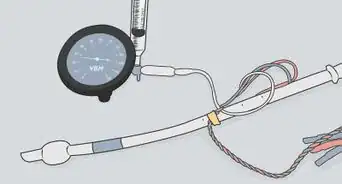
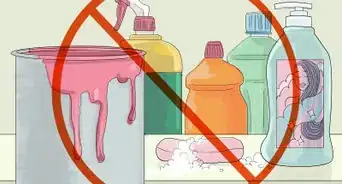

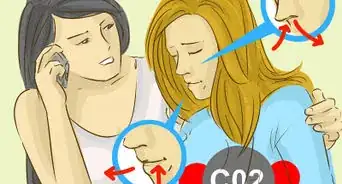

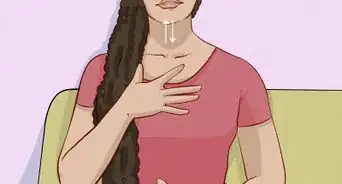













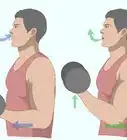
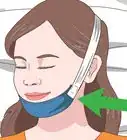
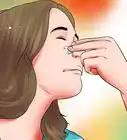




































Medical Disclaimer
The content of this article is not intended to be a substitute for professional medical advice, examination, diagnosis, or treatment. You should always contact your doctor or other qualified healthcare professional before starting, changing, or stopping any kind of health treatment.
Read More...